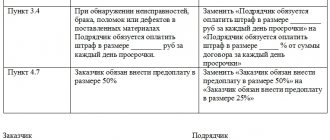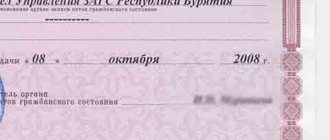Protocol of disagreements to the contract under 44-FZ. What, why and why?
The use of a protocol of disagreements when carrying out procurement in the form of an electronic auction is an important element of this procedure.
The need for such a mechanism is due to the frequent need to make changes to the draft contract and to build some kind of dialogue between the customer and the winner at the stage of concluding the contract in order to clarify details. Let's look in more detail at what a dispute protocol is, how and why it is used, and what nuances the supplier should take into account when drawing up and sending this document.
Protocol of disagreements to the agreement under 44-FZ: deadlines, sample, instructions for drawing up
As a participant in an electronic auction, the winning supplier has the right to agree with the customer on certain terms of the contract with which he does not agree or which require correction due to changed conditions. For example, during the procurement procedure your details have changed, but they are already specified in the contract. What can be done?
In this case, you can draw up a separate document - a protocol of disagreements to the agreement. However, it must be borne in mind that according to 44-FZ, the protocol of disagreements is applicable only in relation to electronic auctions
.
Application cases
You can resort to drawing up a protocol of disagreements to the contract if it is necessary to correct or exclude controversial clauses of the contract, as well as to introduce new ones
. In practice, you may encounter situations in which this measure will be the best, and maybe the only way out. In the example above: your bank details have changed, and you, as a participant who does not have the right to make adjustments to the draft contract, use a protocol to inform the customer that the information requires changes. Another common case that requires correction of the draft contract is the discrepancy between the contractual terms and conditions with those presented in the documentation and/or notice for a particular purchase. The protocol of disagreements to the agreement will allow this issue to be resolved.
Protocol of disagreements: deadlines for registration
In accordance with Article 70 of Law No. 44 - Federal Law, the supplier may send a protocol of disagreements to the Unified Information System within a period not exceeding 13 calendar days from the date of publication of the final protocol. If this deadline is not met, the participant will be considered as having evaded signing the contract. Many suppliers use this document as a way to “delay” extra time to raise funds to secure a contract. To do this, it is enough to indicate the smallest formality that needs to be corrected, for example, adding the OGRN code in the details or changing the current account.
Sample protocol of disagreements to the agreement
Since the legislation does not provide any criteria for drawing up a protocol of disagreements within the framework of 44-FZ, the procurement participant can draw it up in free form.
Instructions for compilation:
If you decide to resort to this measure, it is enough to create an electronic document in any form (for convenience, you can arrange it in the form of a table).
Include in the document all inconsistencies regarding the provisions of the contract. The main condition for the content of the protocol of disagreements under 44-FZ is a specific indication of the discrepancy between the information in the documentation and the draft contract. Information about the product in the protocol and the application should not differ. It is unacceptable to send the customer an adjusted draft contract instead of the protocol; the court will consider this a violation.
You can edit the essential terms of the contract only if they do not correspond to the procurement notice.
Details and contact details of the parties are included in the protocol at your discretion.
Seal the document with the electronic signature of a representative authorized to sign the contract. There is no need to create a scan of the signed document.
Send a protocol of disagreements to the agreement to the electronic platform.
After publishing the protocol of disagreements, the customer will post a revised draft contract in the Unified Information System within three working days, taking into account your comments. If your instructions seem incorrect to the customer, he will re-post the original draft contract, indicating the reasons for the refusal in a separate document.
You, depending on whether you are satisfied with the terms of the draft contract this time or not: either publish the signed contract on the site within three days, not forgetting to provide the contract security, if required, or have the right to prepare another protocol of disagreements.
Normative base
Art. 70, part 4, 5, 6, 13 Federal Law - 44
Letter of the Ministry of Economic Development of Russia dated August 21, 2015 No. D28i-2475,
Determination dated 10/09/2015 No. 308 – KG15 – 13770
Similar articles:
|
Why is a dispute protocol needed?
One of the main features of procurement in the form of an electronic auction is that this procedure, throughout its entire length, eliminates the need for “live” interaction between the customer and the participant. Of course, in practice, nothing can prevent you from organizing a meeting or making a phone call, but contract law prohibits such negotiations.
At the same time, the procurement documentation contains only a draft of the future contract, which lacks a number of key data. When left blank, it is essentially just a template that needs to be supplemented with certain information. In this case, there is often a need to clarify or agree on any details or clauses of the contract.
It is for these purposes that the protocol of disagreements serves - to provide an opportunity to agree on and eliminate all existing shortcomings and disagreements at the stage of concluding a contract. It should be borne in mind that changes made are possible only within the framework permitted by Law No. 44-FZ. Changing the essential terms is prohibited and is a violation.
Sample of drawing up a protocol of disagreements
- At the beginning of the document, its name is indicated, as well as the number corresponding to the document flow.
- Then a link is given in the form of the number and date of the agreement to which the protocol is drawn up.
- Next, enter the full names of the companies between which it is concluded.
- Below is the main part, designed in the form of a table, into which all the necessary edits are entered in order.
- The first column contains the number of the paragraph or subparagraph (sometimes even indicating the paragraph) to which this correction relates.
- The second column includes an excerpt from the original text, the third - its edition (i.e., an adjusted version).
- After all the necessary adjustments have been made, the document is signed by representatives of both parties, indicating their positions and transcripts of signatures.

How to draw up and send a protocol of disagreements?
The formation and direction of the protocol of disagreements is ensured by the mechanisms of the electronic trading platform on which the tenders were carried out and the contract was concluded. However, there are no uniform requirements for the form of this document. The protocol is drawn up in free form using the capabilities provided by the trading platform interface. As a rule, the possibilities are small and limited to composing text and attaching files - this is quite enough.
In practice, if it is necessary to send a protocol of disagreements, some customers draw up official letters signed by the head, scan them and send them to the winner through the trading platform website. This is not prohibited, but there are no mandatory requirements in this regard. The legal significance of the procedure for sending a protocol of disagreements in electronic form is ensured by the use of an electronic digital signature. Therefore, there is no need to write an official letter.
The process of reviewing the protocol and agreeing on conditions
If the conclusion of a transaction is not necessary or the law does not establish special rules for resolving disagreements before signing the contract, the parties are not bound in any way. They decide for themselves how and within what time frame to submit and consider the protocol of disagreements. At the same time, sending and receiving a protocol of disagreements does not oblige you to anything.
When sending a protocol of disagreements, it is advisable to prepare a covering letter. It is compiled in free form. As a rule, it confirms the intention to conclude an agreement, but after agreeing on the disagreements contained in the protocol. To add certainty to the process, it is advisable to indicate in the letter the waiting period for a response. If this period has expired and there is no response, we can conclude that the transaction is refused.
Agreement process:
- The counterparty studies the dispute protocol.
- If he agrees with all the proposals, he signs the protocol and sends one of its copies to the other party.
- If all proposals are rejected, in response to the protocol of disagreements, a refusal to agree on them or a protocol of disagreements with its proposals is sent.
- If you partially agree with the proposals and (or) have your own additional proposals, your protocol for reconciling disagreements is sent.
- The parties are not limited in the number of protocols of disagreements to the agreement sent to each other, but if it is clearly impossible to agree, the option of refusing to agree and concluding a deal is considered.
The result of agreeing on the terms is the final (final) protocol of disagreements signed by the parties. It may look different. For example, if the protocol is immediately agreed upon, then this will be the original document signed by the parties. But if there were several protocols, then the final document, as a rule, contains sections:
- Contract clause.
- Primary formulation of the condition.
- Proposal (editorial) of one side.
- Response proposal (editorial) of the second party.
- Agreed edition.
The protocol, agreed upon on all points and signed by the parties, is an integral part of the agreement. It will be considered concluded from the moment the final version of the protocol is signed.
A protocol drawn up, but not signed by all parties to the transaction, can be changed as many times as desired. Likewise, the number of protocols of disagreement exchanged between the parties is not limited. But if the final protocol has already been signed, then the agreement will be in force as amended. In this case, changes are possible only by signing an additional agreement to the contract.
The procedure for sending a protocol of disagreements
Since only the customer has the opportunity to make changes to the text of the draft contract, the need to send a protocol of disagreements most often arises from the supplier. But technically the customer also has this opportunity.
As an example, we can consider a situation where the customer’s specialist incorrectly specified the details of one of the parties, and the supplier, in turn, signed the draft contract without noticing the error. Having discovered a defect, the customer must send the winner a protocol of disagreements, adjust the draft contract and re-send it for signature.
Time limits for exchange of protocols of disagreements
Meeting deadlines is an extremely important point in the issue of sending a protocol of disagreements. In order to make the first decision on whether to sign the draft contract or draw up a protocol of disagreements, the participant has five days. In the future, both the customer and the winner have three days to exchange documents. In this case, the total duration of such correspondence can be no more than thirteen days, after which the possibility of sending the next protocol and signing a contract will be blocked by the operator of the trading platform.
Deadline for drawing up a protocol of disagreements
By law, the period for drawing up this document is thirty days. However, in practice this period is much shorter, since companies are usually interested in concluding an agreement as early as possible.
After receiving the protocol, the author of the agreement is also obliged to notify the counterparty within a thirty-day period whether he agrees with the amendments made or rejects them.
The contract can only be signed when both parties are completely satisfied with all the provisions of the contract. From the moment it is signed, all future disputes and disagreements regarding its content can be resolved in court (unless, of course, the parties manage to reach an agreement peacefully).







